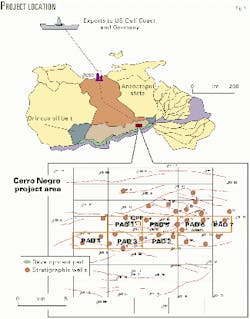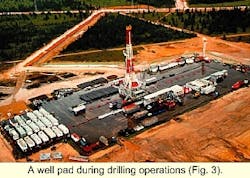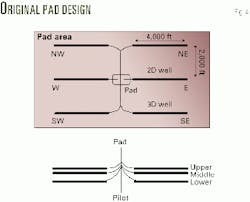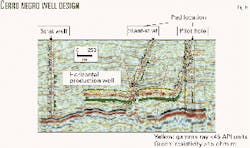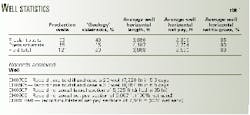Reservoir studies, expendable stratigraphic wells, increased drilling capabilities, and close team work have changed and improved the scheme for producing extra-heavy oil in the Cerro Negro project in Venezuela's Orinoco oil belt.
Project operator Operadora Cerro Negro is a strategic association among ExxonMobil Corp., 41.7%, Petroleos de Venezuela SA (PDVSA), 41.7 %, and Veba Oel, 16.6%. ExxonMobil is operator of the strategic association.
Operadora Cerro Negro to date has drilled 121 horizontal development wells, with an average lateral length of 4,000 ft. Drilling performance improved dramatically throughout this program, as a result of better reservoir understanding and increased drilling capabilities. And improved reservoir models and greater stratigraphic well control reduced geological risk.
This success of the project has required close teamwork between the sub-surface technical team and the drilling team.
Background
The integrated upstream and downstream Cerro Negro project produces extra-heavy (8.5° API gravity) crude from an area near the eastern end of the Orinoco oil belt (Fig. 1). At present, this crude is mixed with condensate (diluent) and transported to Jose, on Venezuela's Caribbean coast, for export to the US Gulf Coast and Germany.
When full production is realized, the crude will be diluted and processed in the field before being piped to an upgrader at Jose. In the facility at Jose, the crude will be upgraded to a 16° API gravity synthetic oil, which will be exported by tanker. The diluent will be piped back to the Cerro Negro field.
Production started in October 1999 at an initial rate of 50,000 b/d of undiluted crude from 35 horizontal development wells. Currently, the field is producing from 70 wells at more than 100,000 b/d of undiluted crude with a low water cut. About 20 million bbl of crude have been produced to date.
After the upgrader is operational in April 2001, full production will reach 120,000 bo/d. Plans are that this 120,000 bo/d plateau rate will be maintained over the 35-year contract life, resulting in about 1.5 billion bbl of extra-heavy crude oil being recovered.
On average, the wells produce about 1,400 bo/d/well, and it is anticipated that wells with more pay, drilled later in the program, could prove to be more productive.
Geology
In the East Venezuela basin, Cretaceous sources rocks generated the hydrocarbons (Fig. 2). These hydrocarbons migrated southwards, updip into extensional fault-bound traps and onward into the Orinoco oil belt, an enormously large stratigraphic trap on the basin's southern margin.
The Orinoco oil belt contains one of the largest trapped hydrocarbon volumes in the world, an estimated 1.2 trillion bbl of oil in place. The oil is trapped in the early Miocene Oficina formation sands.
Cerro Negro produces from the lowermost stratigraphic unit in the Oficina, the Morichal member, at 2,000-4,000 ft. These Morichal sands are subdivided into three informally defined units, the Lower, Middle, and Upper Morichal (Fig. 2).
Reservoir quality is excellent, with an average 32% porosity and average 15-Darcy permeability.
Morichal reservoir sands unconformably overlie a Precambrian igneous and metamorphic basement. These reservoir sands form a transgressive sequence, with fluvial sands at the base and marginal marine sands near the top. An interpretation is that these sands were deposited in valley fairways, with valley incision controlled by climate and sea-level change.
Original plan
The Cerro Negro team initially planned to develop the field with a series of 18-slot well pads (Fig. 3). On each pad the plan called for one vertical pilot hole in the middle of the pad for stratigraphic control and 18 horizontal production wells in a regular pitchfork pattern. Six wells would be in each of the Morichal units (Fig. 4).
The geological model, based on relatively sparse stratigraphic well control (32 wells drilled by Lagoven, a former unit of PDVSA), assumed mostly thick, laterally continuous sands in the central field area. This central area was high-graded and selected for early development. Simulation studies determined well spacing and horizontal well length.
The initial development plan required drilling two and three-dimensional well (2D and 3D wells) profiles (Figs. 4 and 5). The plan called for these wells to be drilled and cased in 13 days/well, with a stretch target of 10 days/well.
This timing was based on limited offset drilling performance data and anticipated performance improvement over the multiwell program.
The drilling campaign required the designing of fit-for-purpose drilling rigs, and contractors were charged with providing the necessary personnel and equipment. The program implemented a continuous improvement process with the stretch drilling rate as the target and with safety as a first priority.
Geological reality
Initial drilling proved problematic.
On the first two pads, 36 horizontal wells, half of the wells required a geological sidetrack and 1 well was suspended. Predicting landing-points and staying in reservoir sand was difficult in the horizontal sections because the geological variability in the reservoir was much greater than originally anticipated.
The sparse stratigraphic well control included in the initial plan did not provide sufficient data for determining the actual lateral and vertical distribution of the target sands.
Because of the low acoustic impedance contrast between reservoir sands and interbedded shales, the 3D seismic data, acquired in 1997 to plan trajectories, proved of limited use in successfully placing the wells.
Improved understanding
Two initiatives reduced geological risk and improved drilling results.
First, a more detailed geological model led to a better understanding of depositional mechanisms and reservoir architecture. This model incorporated quantitative facies analysis for all wells, and valley fairway maps based on well control and seismic data.
Second, additional vertical stratigraphic wells provided a better understand of reservoir continuity and helped define horizontal well targets.
To refine horizontal well trajectories further, slanted stratigraphic wells were drilled from the development pads (Fig.6). These "slant-strats" have helped define landing points and mid-lateral stratigraphic reservoir continuity.
To date, 15 slant-strat wells have been drilled, on five pads. These wells have greatly reduced the number of geological sidetracks to less than one in six, which has significantly reduced well capital expenditures even after including the cost of the additional slant-strat wells.
In the horizontal wells, the gross horizontal well length, horizontal net pay length, and net to gross have all increased (Table 1).
Increased capabilities
A continuous improvement effort from inception of the drilling program captured lessons learned and tracked progress through a learning curve, so that the program surpassed the 10 days/well stretch target.
Over the course of 121 wells drilled and cased, the newest wells required only an average 8.4 days/well compared to the 14.1 days/wells for the initial wells. This represents an overall reduction of 40% in time and 30% in costs (Figs. 7 and 8).
For all wells, an average 9.6 days were required to drill and case a well.
Table 1 shows the excellent well statistics achieved. This performance resulting in completing the drilling 2 months ahead of schedule and within the original budget scope.
Early in the project, borehole instability problems, primarily in the Upper Morichal sand, affected the drilling performance by sticking drilling assemblies. To improve drilling performance, a quantitative risk-assessment technique evaluated the borehole-stability problem and recommended higher mud weights.
This assessment and results from a micro-frac test performed in the field led to the development of a wellbore-stability model to predict required mud weights. The implementation of this model reduced the frequency of sticking incidents from 1 in every 2 wells to 1 in every 12 wells.
The continuous improvement efforts include:
- Health and safety excellence. Prior to the execution of critical operations, a job safety analysis stressed the safety elements of the work to be performed.
- Environmental awareness. Processed drill cuttings went into road surfacing or landfills, and dewatered excess mud volumes were recycled with the clean water providing an irrigation source.
- Drilling practices. Optimized hole cleaning and conditioning practices effectively removed cuttings beds.
- Directional control. Careful planning and monitoring of sliding and rotating schedules provided the desired dog-leg severity. Specifically written guidelines determined the first build section, the tangent section for placement of the producing pump (progressive cavity type), the second build section, and the horizontal section.
- One bottomhole assembly (BHA) per bit run per hole. Appropriate drilling assembly (BHA, bent-housing, and bit) selection allowed for the required build rates in the first build section above the pump tangent and the build and turn rates for landing the well in the reservoir. Bits have to withstand high penetration rates, tolerate high side loads while drilling abrasive sands, and last through frequent back-reaming operations.
- Downhole vibrations. Monitoring of drilling parameters minimized detrimental downhole vibrations that caused failure of drilling assembly components and unusable logging-while-drilling (LWD) data.
- Drilling fluids. The wellbore stability model called for increased mud density that minimized sticking incidents, and a modified drilling-fluid formulation lowered costs while meeting specifications. Mud management focused on optimizing additives and controlling mud properties to lessen formation damage.
- Skidding time between slots. The fit-for-purpose rig design included a skidding system that minimized time required to skid between slots (1.5 hr), while leaving the drill pipe and drilling assembly in the derrick rack.
- Flat time reduction. The drilling program decreased the flat (non-productive) time by 50%, by reducing the time for rigging up and down downhole and casing running tools, running tubulars, preparing cement jobs, installing wellheads, and testing the well.
Future pad design
The first development phase of Cerro Negro drilling included 121 horizontal producing wells.
Future pad designs will be based less on the restricted regular pitchfork design and more on the subsurface geology.
Plans are to design trajectories based on a reservoir model that continues to be improved.
Also, improved drilling capabilities will allow:
- Wells to be landed further from the development pad location.
- Longer horizontal lateral sections with increased contacted oil volumes.
- Multilateral wells targeted for thinner more difficult sands.
The authors
Gary Robertson is geoscience supervisor for Operadora Cerro Negro, Caracas. He holds a BS in geology from the University of Aberdeen and a PhD in Geology from the University of Edinburgh. Robertson is a member of AAPG, Petroleum Exploration Society of Great Britain (PESGB), and is a fellow and chartered geologist of the Geological Society.
René Santos is technical manager for Operadora Cerro Negro, Caracas. He holds an MS in petroleum engineering from the University of Texas and an MBA from the University of Houston. He is a member of SPE.
Milton Vasquez is lead drilling and completions engineer for Operadora Cerro Negro, Caracas. He has worked in drilling operations in the Gulf of Mexico and various international assignments, including Nigeria, Vietnam, and most recently in Venezuela. Vasquez holds an MS in petroleum engineering from the University of Tulsa. He is a member of SPE.
